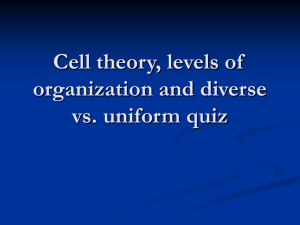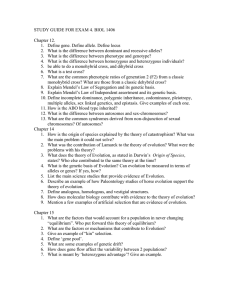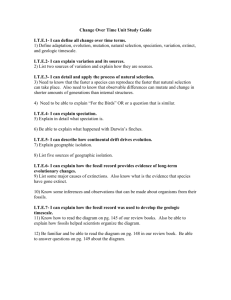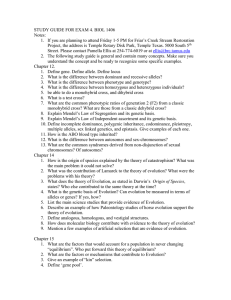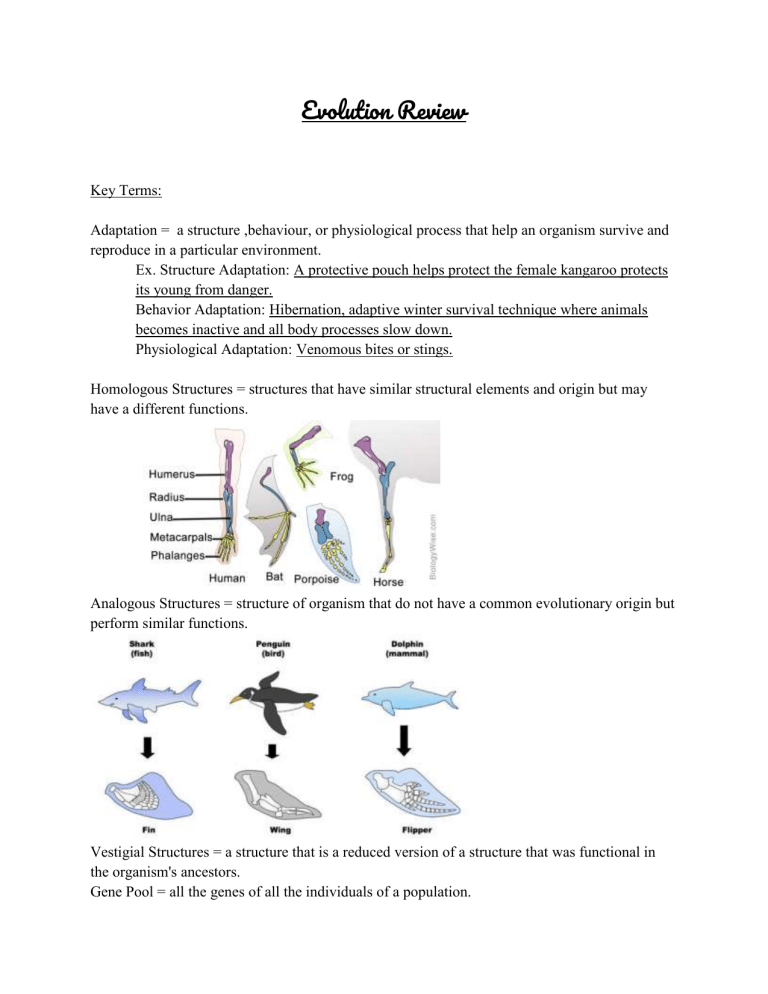
Evolution Review Key Terms: Adaptation = a structure ,behaviour, or physiological process that help an organism survive and reproduce in a particular environment. Ex. Structure Adaptation: A protective pouch helps protect the female kangaroo protects its young from danger. Behavior Adaptation: Hibernation, adaptive winter survival technique where animals becomes inactive and all body processes slow down. Physiological Adaptation: Venomous bites or stings. Homologous Structures = structures that have similar structural elements and origin but may have a different functions. Analogous Structures = structure of organism that do not have a common evolutionary origin but perform similar functions. Vestigial Structures = a structure that is a reduced version of a structure that was functional in the organism's ancestors. Gene Pool = all the genes of all the individuals of a population. Speciation = the formation of new species from existing species. Selective Advantage = a genetic advantage that improves an organism's chance of survival, usually in a changing environment. Ex. A camel being able to store water in hump in the desert. Variation = differences between individuals, which may be structural, functional, or physiological. Monoculture = extensive planting of the same varieties of a species over large expanses of land. Mimicry = a structural adaptation in which a harmless species resembles a harmful species in coloration or structure. Selective Pressure = environmental conditions that select for a certain characteristics of an individual and select against other characteristics. Ex. Giraffes neck had to adapt to become large enough to reach fruit. Artificial selection = selective pressure exerted by humans on populations in order to improve or modify particular desirable traits. Ex. Different types of cows through selective breeding. Extinct = describes a species that has completely disappeared from earth. Fitness = the relative contribution an individual makes to the gene pool of the next generation by producing offspring that will survive long enough to reproduce. Mutation = a permanent change in the genetic material of an organism; the only source of genetic variation Examples To Know: ● Drug-resistant bacteria ○ Staphylococcus aureus bacteria, bacteria adapted to antibiotic(new alleles were produced to provide protection) and became immune to it and passed the trait on to their offspring.(Selective Advantage) ● Peppered Moths ○ Before the industrialization white peppered moths were abundant whereas their black counterpart were nearly extinct. ■ WHY? ● Their appearance affects their survival in their environment. If you are black you will be easily spotted by predator, if you are white you can blend in with your surrounding to increase chance of survival. ○ During industrialization the tables turned, white nearly became extinct they were not able to blend in with the environment anymore. Theories to Know: ● Charles Darwin ● ● ● ● ● ○ Natural Selection = the process by which characteristics of a population change over many generations as organisms with advantageous heritable traits survive and reproduce passing their traits to their offspring. ○ Survival of the fittest = a phrase coined by John Spencer, expressing the idea that in the struggle for survival , the reproductively fittest organism win because they are better adapted to environment. ○ Descent with modification = Darwin's theory that natural selection does not demonstrate progress, but merely results from a species ability to survive local conditions at a specific time. ○ Contribution to the theory of evolution = ■ Organism produce more offspring than can survive. Therefore organisms compete for limited resources. ■ Individuals of a population vary extensively, and much of this variation is heritable. ■ Individual that are better suited(fitted) to local conditions survive to produce more offspring. ■ Processes for change are gradual. Charles Lyell ○ Contributions to the theory of evolution: ■ Suggested that a slow and continuous process could could result in substantial changes in the long term. ○ Uniformationism = geological processes in the past operate at the same rate they do today. Georges Cuvier(Paleontology) ○ Created the founding field of paleontology(study of fossils). ○ Catastrophism = cataosprohies killed many organisms ○ Connection between strata and fossils: ■ Each stratum(layer) of rock help a unique group of fossils species. Discovered that the oldest fossils are in the deepest layer. ■ Catastrophic events corresponded to the boundaries between the fossil strata. Jean-Baptiste Lamarck ○ Inheritance of acquired characteristics = characteristics acquired during an organism's lifetime could be passed onto offspring. Thomas Malthus ○ Essay on the principles of population → explained hoe population might change over time ■ KEY IDEA = population produce far more offspring than their environments can support. Wallace ○ Made observation and conclusions similar to Darwin’s. ○ Darwin and Wallace recognized the importance of Malthus work ● George-Louis Leclerc ○ One of the first people to propose that life time are changing. ○ Speculate that Earth was more than 6000 years old. ● Mary Anning ○ Worked as a fossil hunter ○ Uncovered the first plesiosaur ○ Work was confirmed by George Cuvier(founder of Paleontology) Evidence for Evolution ● Fossil Evidence ○ Fossil Record = reveals the evidence of Earth. ○ Fossil Record provides the following evidence: ■ Fossils in younge rock are more similar to current species than those in deeper strata. ■ Fossil appear in chronological order in the rock strata. Older ancestors are found in older rocks ■ Not all organism appear in the fossil record at the same time, showing the successive evolution of group of species ○ Transitional fossils = show an intermediary link between past and present groups of organisms. ○ A key piece of evidence is a fossil record that shows the once functional use of a present day vestigial structure. ● DNA evidence ○ Evolutionary relationships are reflected in DNA since DNA carries genetic information from generation to generation. ○ Organisms that have similar DNA share a common ancestor. ● Biogeography ○ Biogeography = the study of the past and present geographical distribution of organisms. ○ Darwin and Wallace supported their theories with biogeographical evidence showing that species evolved in one location and spread out to other locations. ● Anatomy ○ Homologous Structures = are those that have similar structural elements and origin but may have a different function. ○ Analogous Structures = do not have a common evolutionary history but perform similar functions. ● Embryology ○ Embryology = the study of pre birth stage of an organism's development ○ Generally, related species share common embryological stages and timing of structural developments ■ All vertebrate embryos have paired pouches or outpocketings of the throat. Factors that affect Frequencies in Populations ● Mutations ○ Mutations are source of genetic variation and thus the evolutionary factor ■ Genetic diversity in a population allows an organism to have a selective advantage in a changing environment ○ Ex. It is likely that an allele already existed in the Norway rat population that gave some individuals resistant to the poison warfarin. When warfarin was applied, those individuals survived, reproduced, and passed on the allele. This selective advantage changed the allele frequency of this characteristics. ● Gene Flow ○ Gene flow = describes the net movement of alleles from one population to another as a result of migration of individuals. ○ Ex. Grey Wolves will often travel great distances to find a neighbouring pack and mate with an individual in that pack. This brings new alleles into the distant pack and may change the allele frequencies and increase genetic diversity. ● Non Random Mating ○ Non Random Mating = mating among individuals on the basis of particular phenotype or due to inbreeding. ■ In animals, individuals choose their mate based on physical or behavioural characteristics.This will affect the alleles in the gene pool of the next generation, ○ Ex. The male caribou spar with each other to be able to mate with a female in the herd. This prevents particular phenotypes from breeding and passing on their genes. ● Genetic Drift ○ Genetic Drift = the change in frequencies of alleles due to random events in a small breeding population. ■ The Founder Effect ● Often, new populations in areas like islands are formed by only a few individuals or founders. These founders carry some but not all of the alleles from the original populations gene pool. They may also not be typical of the population they came from. Inevitably the gene pool is reduced. ■ The Bottleneck Effect ● If a population is quickly reduced by starvation, disease, or a natural catastrophe, the surviving population has only a fraction of the alleles that were present before the population declined. The gene pool will have lost its diversity, and allele frequencies will have changed. ● Natural Selection ○ Stabilizing selection = favours an intermediate phenotype and acts against extreme variants of this phenotypes. This improves the adaptation of the population to aspects of the environment that remain fairly constant. ○ Directional Selection = favours the phenotypes of one extreme over the others. This type of selection is common during times of environmental change or when a population migrates to a new habitat ○ Disruptive selection = favour two extremes of a population. As a result, intermediate phenotypes can be eliminated from the population. Reproducing Isolation in regard to Speciation ● Prezygotic Isolation Mechanism(Prevention of Mating) ○ Behavioural Isolation ■ Any special signal or behaviours that are species-specific prevent interbreeding with closely related species ● Ex. Eastern meadowlark and western meadowlark. Their habitats overlap but due to differences in their songs they do not mate. ○ Temporal Isolation ■ Two species may occupy the same habitat amd have timing barriers, such as mating or flowering at different times of the day, different season, or different years ● Ex. Three types of orchids live in the same area but flower on different days. This prevents fertilizations among the orchids. ○ Ecological/Habitat Isolation ■ Two species may live in the same general region but in different habitats, so they may rarely encounter each other. ● Ex. Common garter snake and Northwest garter snake. Both live in the same area, but one prefer meadows and one resides near water. ● Prezygotic Isolation Mechanism(Prevention of Fertilization) ○ Mechanical Isolation ■ Two closely related species may attempt to mate but are successful due to anatomical incompatibility.(distinct genital anatomy or flower structure prevents lock-and-key fit) ● Ex. The genitals of some insects operate in a kind of lock and key system. The genitals are so distinct that they prevent successful fertilization of another species ○ Gametic Isolation ■ Gametes from two different species may meet but do not fuse to form a zygote. ● Ex. The sperm of one species may not be able to survive in the environments of the female reproductive tract of another species. ● Postzygotic Isolating Mechanism(Prevention of hybrids) ○ Hybrid Breakdown ■ The F1 two-species offspring produces viable hybrid offspring. However, these F2 cannot produce viable fertile breakdown. ● Ex. Goat and Sheep: Embryos from these species die in early development due to dysfunctional mitosis. ○ Hybrid Inviability ■ Genetic incompatibility of the interbred species may stop development of the hybrid zygote. ● Ex. Cotton Plants: Different species of cotton plants cross, but their hybrid offspring produce wheal and sterile seeds. ○ Hybrid Sterility ■ The hybrid offspring is sterile, representing a reproductive barrier ● Ex. Female horse and male donkey: These species produce offspring called mules that are sterile due to dysfunctional meiosis. Impact of Human activity on speciation, population decline and extinction. ● Human activities have had great impact on speciation, population decline, and extinction. Many activities essentially isolate populations. For example, these human-made barriers are resulting in allopatric speciation (due to geographical isolation) and need to be monitored closely: ○ conversion of wilderness into cropland ○ development of areas for tourism ○ building urban subdivisions and roads ● Outcomes include: ○ speciation through adaptive radiation after geographical isolation ○ speciation through genetic drift after a bottleneck effect ○ species endangerment and/or extinction due to insufficient genetic diversity from population isolation.
